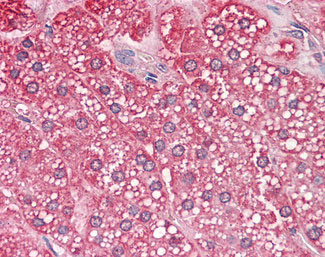QSOX2 Antibody (Internal)
Rabbit Polyclonal Antibody
- SPECIFICATION
- CITATIONS
- PROTOCOLS
- BACKGROUND

Application
| IHC-P |
|---|---|
| Primary Accession | Q6ZRP7 |
| Reactivity | Human, Mouse, Monkey, Horse |
| Host | Rabbit |
| Clonality | Polyclonal |
| Calculated MW | 78kDa |
| Dilution | IHC-P (20 µg/ml) |
| Gene ID | 169714 |
|---|---|
| Other Names | Sulfhydryl oxidase 2, 1.8.3.2, Neuroblastoma-derived sulfhydryl oxidase, Quiescin Q6-like protein 1, QSOX2, QSCN6L1, SOXN |
| Target/Specificity | Human QSOX2. BLAST analysis of the peptide immunogen showed no homology with other human proteins. |
| Reconstitution & Storage | Long term: -70°C; Short term: +4°C |
| Precautions | QSOX2 Antibody (Internal) is for research use only and not for use in diagnostic or therapeutic procedures. |
| Name | QSOX2 |
|---|---|
| Synonyms | QSCN6L1, SOXN |
| Function | Catalyzes the oxidation of sulfhydryl groups in peptide and protein thiols to disulfides with the reduction of oxygen to hydrogen peroxide. May contribute to disulfide bond formation in a variety of secreted proteins. Also seems to play a role in regulating the sensitization of neuroblastoma cells for interferon-gamma-induced apoptosis. |
| Cellular Location | Membrane; Single- pass membrane protein. Secreted. Cell membrane; Single-pass membrane protein. Nucleus membrane; Single- pass membrane protein. Note=Seems to be predominantly targeted to the nuclear and outer plasma membrane |
| Tissue Location | Expressed in pancreas, brain, placenta, kidney, heart and fetal tissues. Weakly expressed in lung, liver and skeletal muscles. |
| Volume | 50 µl |

Thousands of laboratories across the world have published research that depended on the performance of antibodies from Abcepta to advance their research. Check out links to articles that cite our products in major peer-reviewed journals, organized by research category.
info@abcepta.com, and receive a free "I Love Antibodies" mug.
Provided below are standard protocols that you may find useful for product applications.
Background
Catalyzes the oxidation of sulfhydryl groups in peptide and protein thiols to disulfides with the reduction of oxygen to hydrogen peroxide. May contribute to disulfide bond formation in a variety of secreted proteins. Also seems to play a role in regulating the sensitization of neuroblastoma cells for interferon-gamma-induced apoptosis.
References
Wittke I.,et al.Cancer Res. 63:7742-7752(2003).
Humphray S.J.,et al.Nature 429:369-374(2004).
Ota T.,et al.Nat. Genet. 36:40-45(2004).
Bechtel S.,et al.BMC Genomics 8:399-399(2007).
Daub H.,et al.Mol. Cell 31:438-448(2008).
If you have used an Abcepta product and would like to share how it has performed, please click on the "Submit Review" button and provide the requested information. Our staff will examine and post your review and contact you if needed.
If you have any additional inquiries please email technical services at tech@abcepta.com.













 Foundational characteristics of cancer include proliferation, angiogenesis, migration, evasion of apoptosis, and cellular immortality. Find key markers for these cellular processes and antibodies to detect them.
Foundational characteristics of cancer include proliferation, angiogenesis, migration, evasion of apoptosis, and cellular immortality. Find key markers for these cellular processes and antibodies to detect them. The SUMOplot™ Analysis Program predicts and scores sumoylation sites in your protein. SUMOylation is a post-translational modification involved in various cellular processes, such as nuclear-cytosolic transport, transcriptional regulation, apoptosis, protein stability, response to stress, and progression through the cell cycle.
The SUMOplot™ Analysis Program predicts and scores sumoylation sites in your protein. SUMOylation is a post-translational modification involved in various cellular processes, such as nuclear-cytosolic transport, transcriptional regulation, apoptosis, protein stability, response to stress, and progression through the cell cycle. The Autophagy Receptor Motif Plotter predicts and scores autophagy receptor binding sites in your protein. Identifying proteins connected to this pathway is critical to understanding the role of autophagy in physiological as well as pathological processes such as development, differentiation, neurodegenerative diseases, stress, infection, and cancer.
The Autophagy Receptor Motif Plotter predicts and scores autophagy receptor binding sites in your protein. Identifying proteins connected to this pathway is critical to understanding the role of autophagy in physiological as well as pathological processes such as development, differentiation, neurodegenerative diseases, stress, infection, and cancer.


